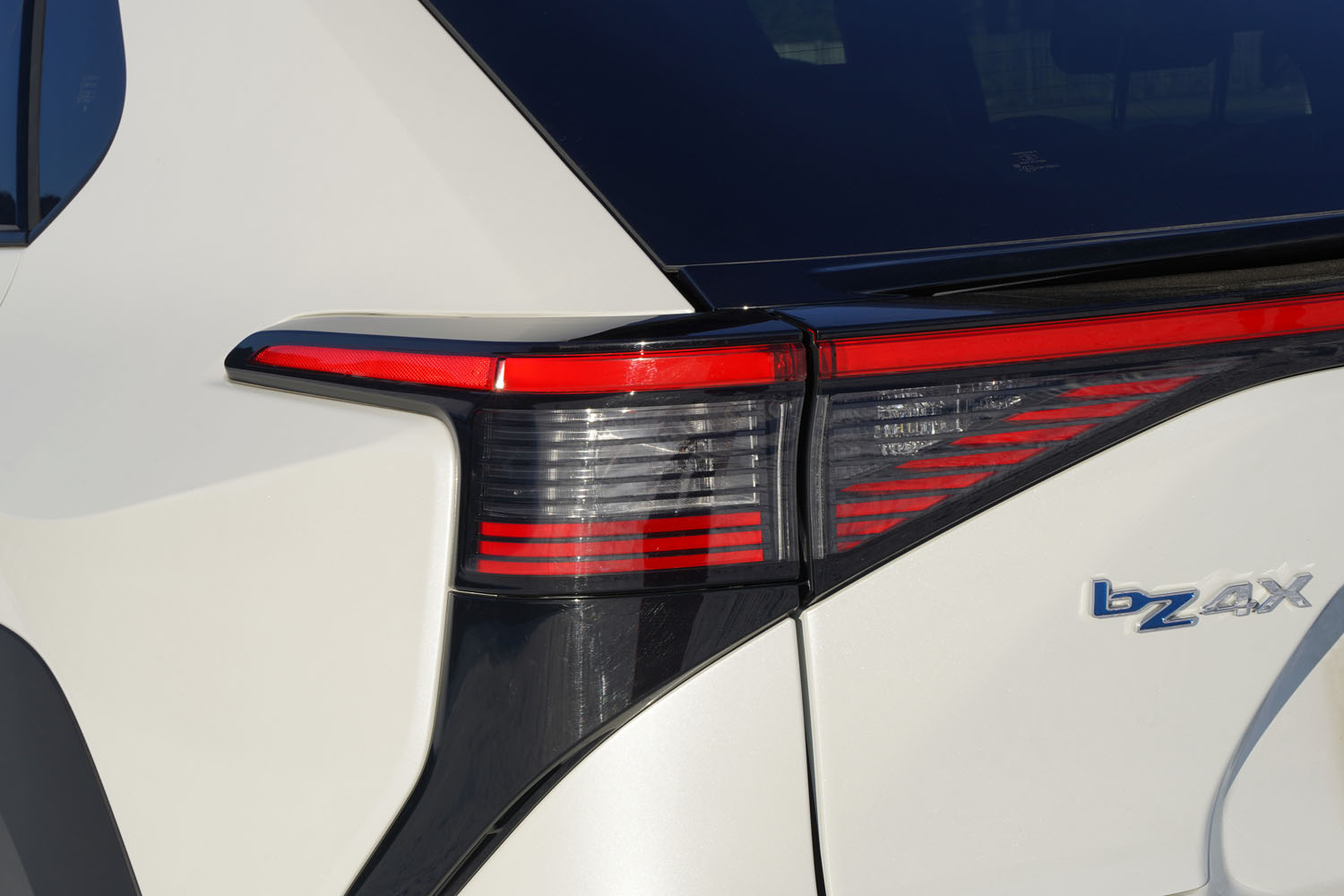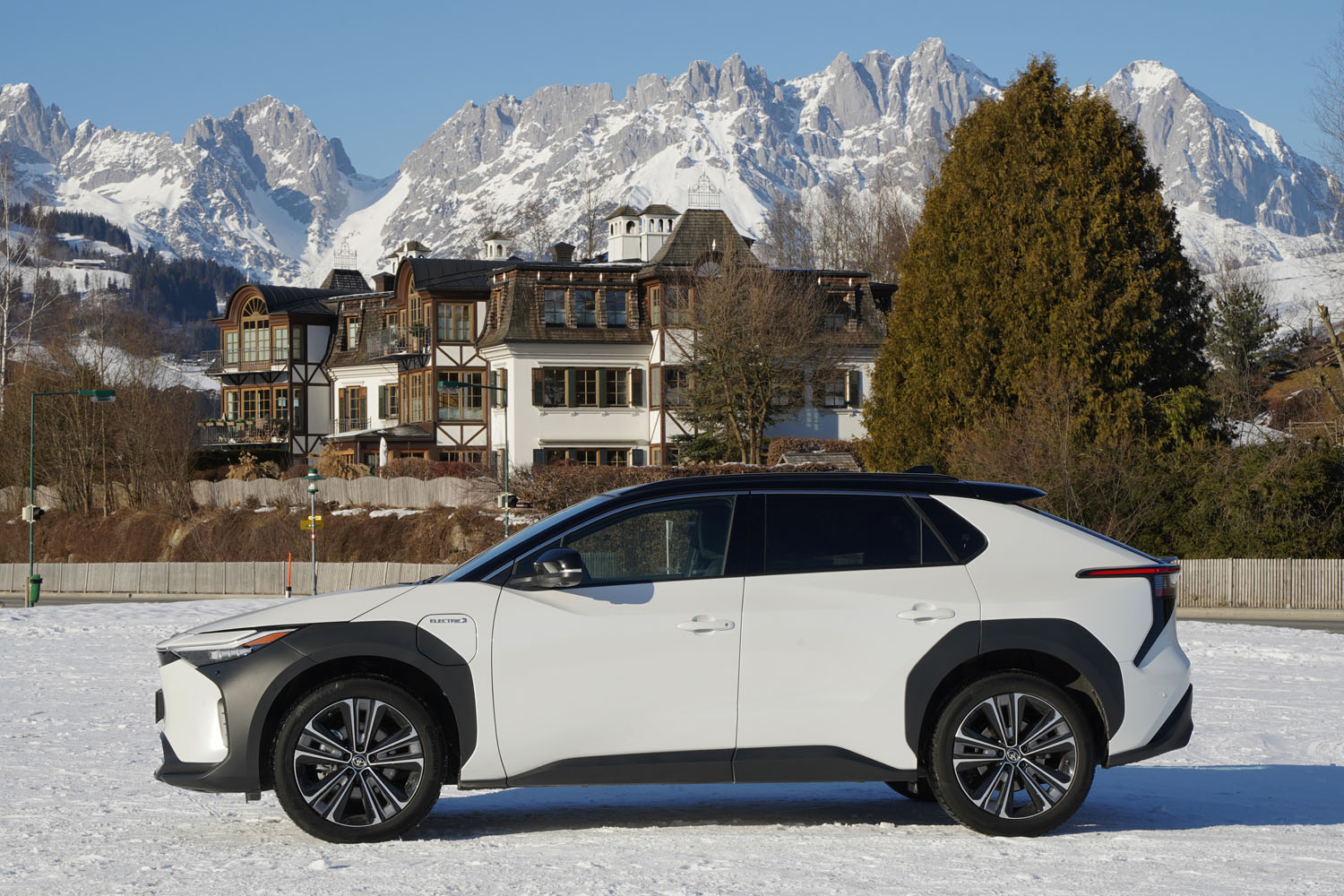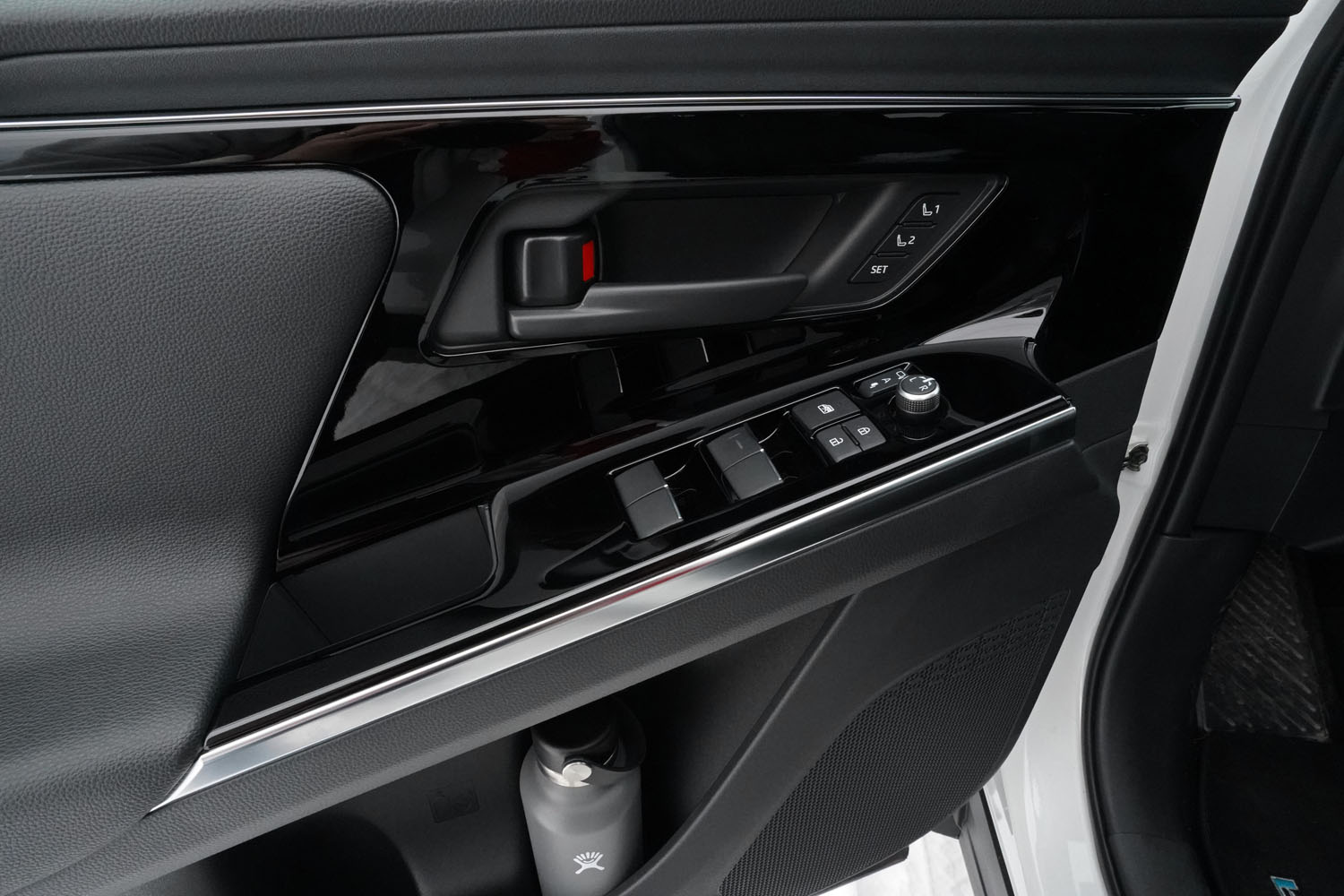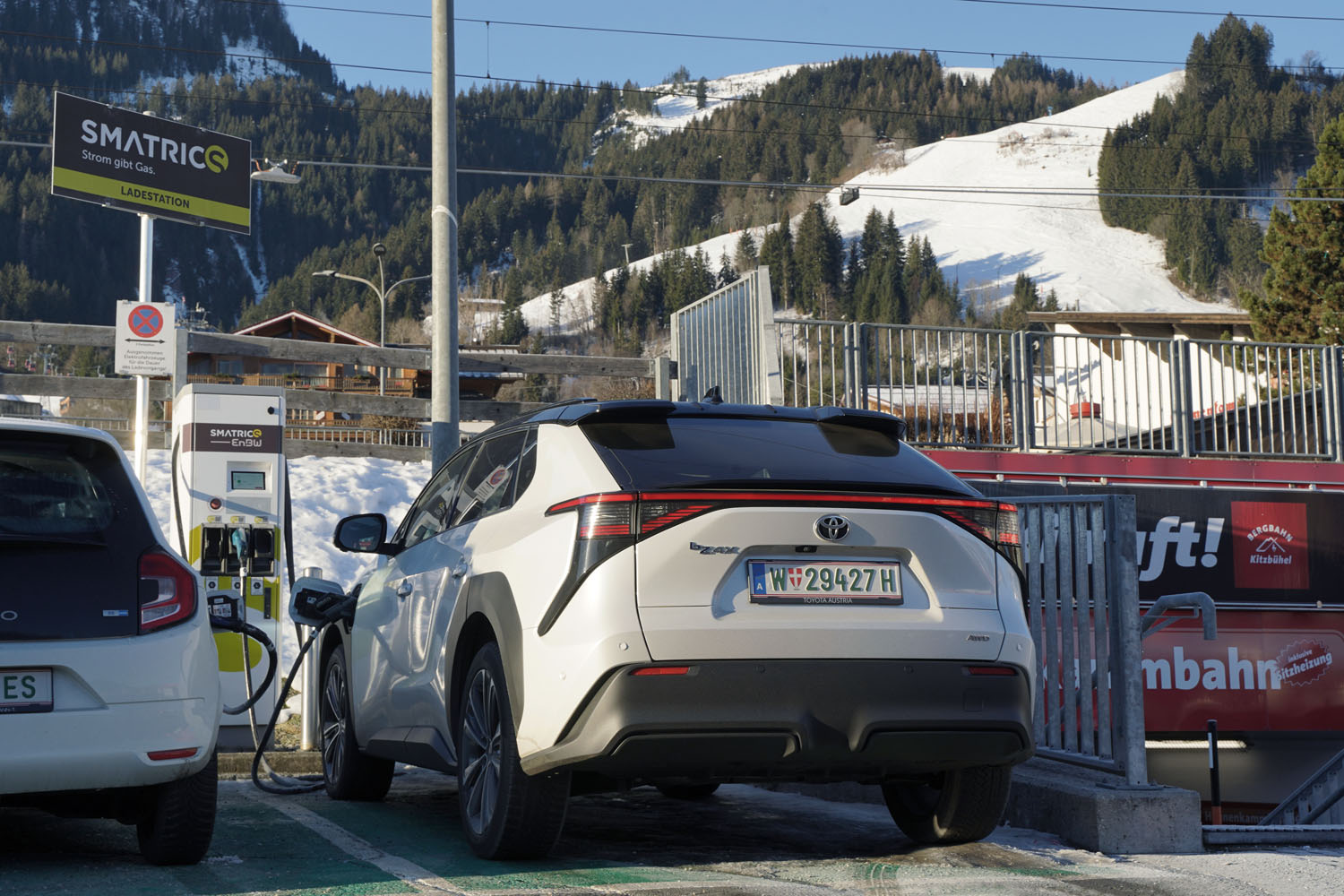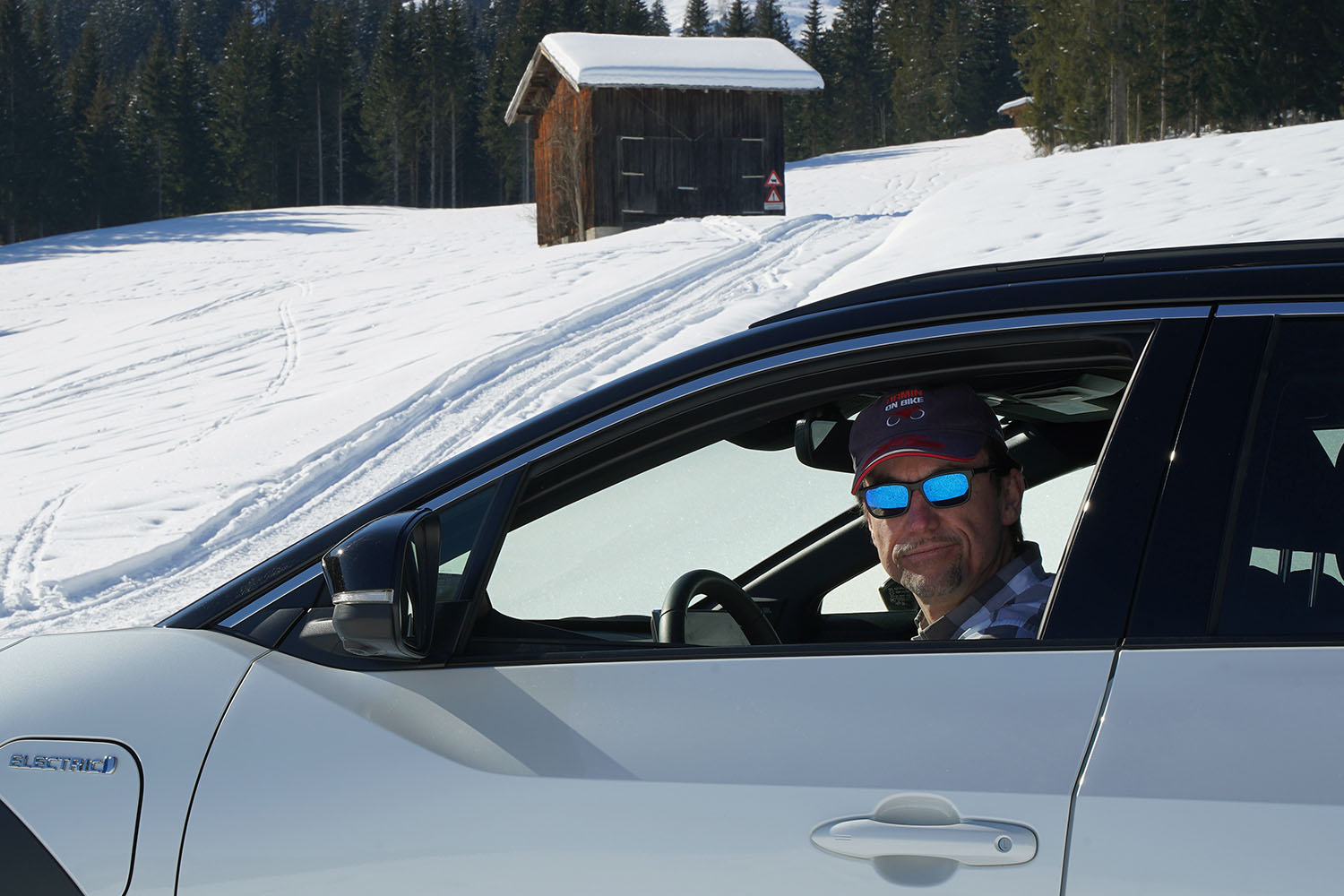Fieberbrunn | Tyrol – On the market since summer of 2022, the Toyota bZ4X is the first purely electric vehicle from the world’s largest carmaker. It’s a late start for Toyota, as the company had previously relied on hybrid and hydrogen technology for alternatives to conventional cars. My wintertime test showed how well the electric car copes with the cold season…
It all began at the car dealer ÖFAG, which offers Opel, Nissan and Toyota models at four locations in the province of Salzburg. Toyota Austria had delivered the test vehicle to the Salzburg branch for me to pick up. There it stood in front of me for the first time: the fully-equipped, all-electric Toyota bZ4X with all-wheel drive. Its appearance, with the angular contour and large 20-inch alloy wheels, makes a strong impression. In terms of design, it struck me as more modern than the comparable Toyota RAV4, but not as futuristic as some other EVs. The paint color, called “platinum pearl-white metallic” gives the E-SUV a very stylish look, especially in combination with the black roof and the matching trim on the wheel arches.
FIRST TOYOTA ON THE e-TNGA PLATFORM
The new modular platform was developed by Toyota specifically for electric vehicles and is being put to use for the first time in the bZ4X. Due to its modularity and scalability, it will also serve as the basis for future bZ models. The drive battery installed under the floor of the car serves as a load-bearing element and contributes to the vehicle’s low centre of gravity. The handling of the crossover SUV won me over during the test. With its firm but not unwieldy chassis, the car grips the road firmly and moves quite dynamically for a two-tonner. The four-wheel drive also helps. An 80 kW (107 hp) electric motor powers both the front and rear axles. For efficiency, the rear unit is only switched on when necessary. For everyday use, the 160 kW (215 hp) system output and 336 Nm of torque offer plenty of excitement. The sprint from zero to 100 km/h takes 6.9 seconds, and the excellent traction reassures safety during overtaking manoeuvres.
ALL-WHEEL DRIVE WITH SPECIAL OFF-ROAD FUNCTIONS
The bZ4X is available with either front- or all-wheel drive. For the winter test, my test vehicle was equipped with all-wheel drive. The X-Mode all-wheel drive system, developed by Toyota in connection with Subaru, gives the midsize SUV exceptional off-road capability, as I saw for myself on the icy road up to the Alpine winter resort Lärchfilzhochalm. I selected the drive mode called “snow/gravel.” This allowed the bZ4X to drive effortlessly even on the steepest stretches, with the electronic stability control only having to intervene briefly on occasion. Other drive modes are available for rougher terrain.
COMFORTABLE INTERIOR OFFERS PLENTY OF SPACE
I unlocked the car by pulling the door handle and took a seat on the perforated textile leather. The seats are both heated and ventilated, and the driver’s seat can be electronically adjusted in every conceivable direction. In front of me, the 7-inch LCD multimedia display is mounted close to the windshield and shows all the most important driving data. Most of the settings can also be changed here. I was somewhat disappointed that it did not show the battery level in percent. Instead of showing up on the display, it can only be pulled up on your smartphone via the free Toyota app, “MyT”. The small, blue bar with no scale is not the most useful as a “fuel gauge”. The centre-mounted 12.3-inch full-HD touch display contains every multimedia application, as well as the perfectly functional navigation system, which sadly does not include route planning. The car also connects to Wi-Fi when stationary and can be used to surf the web. Conveniently, the climate control is separated from the display and is very simple to use via the paddles and touch keys underneath.
When I pressed the brake and power button simultaneously, the seat moved into position and the EV came to life. Then, I just needed to press and turn the central shifter wheel to select D as in “drive” and it was off to the races. There are several switches located around the control wheel. Among them is the switch for one-pedal driving, where increased brake regeneration lets you drive almost without any additional braking. After a bit of familiarisation, I found my way around the button landscape. The only issue is the smartphone compartment in front of the buttons, which annoyingly opens and closes and makes for awkward handling.
The storage compartments under and in the centre console are spacious. There is also plenty of space in the door panels; you can even fit a 1-liter bottle in the back. However, the bZ4X lacks the familiar glove compartment. The rear passengers will find the space just as generous as the driver and front passenger. The trunk is not huge, with a capacity of just 452 litres, but it is perfectly adequate. If necessary, the rear seat backrests fold down in a 60:40 ratio to significantly increase the volume.
COLD-WEATHER RANGE – NOTHING TO WRITE HOME ABOUT
The drive battery with water cooling has a gross capacity of 71.4 kWh. At temperatures around freezing, the bZ4X could not come close to achieving the specified WLTP range of 415 kilometres (258 miles). When we set off in Salzburg, the outside temperature was 1 degree Celsius (34° F). With a full battery and the air conditioning in eco mode, the range forecast indicated 278 kilometres (173 miles). This meant that the air conditioning cost around 100 kilometres (62 miles) or 25 percent of the total range. It was a different picture with the air conditioning off. 371 kilometres (231 miles)—close to the factory specification—but of course, it’s only a theoretical value in winter.
In practice: after just one kilometre (just over half a mile), the forecasted range dropped by 21 down to 257 kilometres (160 miles). After driving two days and 231 kilometres (144 miles) in temperatures between 2 and minus 5 degrees Celsius (35° to 23° F), I headed for a first charge in Kitzbühel with 11 percent battery. I extrapolated that this resulted in a range of around 260 kilometres (162 miles), just over 60 percent of the WLTP range. All electric vehicles experience range loss at low temperatures, but the test showed this to be especially apparent in the bZ4X.
LOW TEMPERATURES REDUCE CHARGING SPEED
According to Toyota, the bZ4X achieves a maximum charging power of 150 kW with direct current. This looked somewhat different at low temperatures. At the first charging station at the Kapser Kreisel parking lot P6, where (according to the City of Kitzbühel) charging is possible with at least 120 kW, I reached a maximum charging power of 66 kW. Another bZ4X driver, who was charging there at the same time, had a similar experience. Whether the low charging power was due to the car, the charging station or the below-freezing temperatures, I cannot judge.
Things went better at a 350 kW Ionity fast charging station at the Angath/Nord freeway service station in the Kufstein district. At an outside temperature of 7 degrees Celsius (45° F), I was able to achieve a maximum charging power of 94 kW, which let me charge from 14 to 80 percent in 35 minutes. That was a good amount, and practical for long-distance trips. I noticed that the charging power dropped sharply from 80 percent SoC, dipping below 20 kW. I usually like to charge above 80 percent on longer highway trips in order to reach my destination without an additional charge, but in this case, it would have been too time-consuming. Since the Smatrics charging card didn’t work there, I had to pay 0.79 euros/kWh via the Ionity app with a credit card, which meant 34 euros for 43 charged kWh. During another DC charge, this time at the 50 kW Smatrics charging station at the P1 Hahnenkammbahn parking lot in Kitzbühel, I managed a continuous maximum charging power of 35 kW at an outside temperature of minus 4 degrees Celsius (25° F).
SIMILAR PICTURE FOR ALTERNATING CURRENT CHARGING
In the first generation and thus also in the test vehicle, the bZ4X has a 1-phase onboard charger with a maximum charging power of 6.6 kW. In the current version, which has been available since December 2022, Toyota has made improvements and switched to 3-phase AC charging. This should make the class-standard 11 kW possible. When testing at the 22 kW Smatrics charging station in Fieberbrunn, I was able to get a charging performance of 4.5 kW on average. With a battery level of 63 percent, the E-SUV indicated a charging time of 6:50 hours for a charge to 100 percent. That’s no problem if you can charge at home overnight or at the office during the day with a wallbox. On the road, the charging speed pretty limiting. Most of the time, you have to rely on DC charging, which is still somewhat of a challenge in the Kitzbühel district due to the low coverage.
ARMIN ELECTRIC CONCLUSION
With the bZ4X, Toyota has taken a major step in the direction of all-electric vehicles. Design, drive, chassis and comfort are in line with the brand’s aspirations. However, the first version of the bZ4X was not quite convincing during winter testing in terms of the key characteristics for electric vehicles, such as range and charging performance. The range of 260 kilometres (162 miles), a consumption of around 25 kWh/100 kilometres (62 miles) and the low charging performance at freezing temperatures show that there is still room for improvement here. Toyota should definitely make some improvements to ensure the otherwise excellent electric SUV more practical in winter.
Towards the end of the 871-kilometre (541 mile) test, when warmer temperatures set in, the Toyota bZ4X felt much more comfortable. At over 10 degrees Celsius (50° F), the average consumption dropped to below 20 kWh/100 km. During the final charging stop at the 300 kW Smatrics charging station in the parking lot of the Salzburg Designer Outlet, I reached an excellent maximum charging power of 134 kW at an outside temperature of 17 degrees Celsius (45° F). In the process, the battery level went from 11 to 80 percent SoC in a quick 31:38 minutes.
In Austria the price of the front-wheel-drive Toyota bZ4X starts at 51,290 euros (£45,710 in the UK, $43,760 in the US). The all-wheel drive model will run you at least 54,170 euros (£52,110 in the UK, $45,840 in the US). With the price increase of 3,000 euros, the maximum charging capacity of the onboard charger was increased from 6.6 kW (1-phase) to 11 kW (3-phase) in December 2022. The top-of-the-line test vehicle, equipped with the Comfort and Executive packages as well as the Style package, is currently priced at 65,210 euros in Austria.
Text and photos: Armin Hoyer – arminelectric.com
Translation from German to English: Ethan Shenhar



